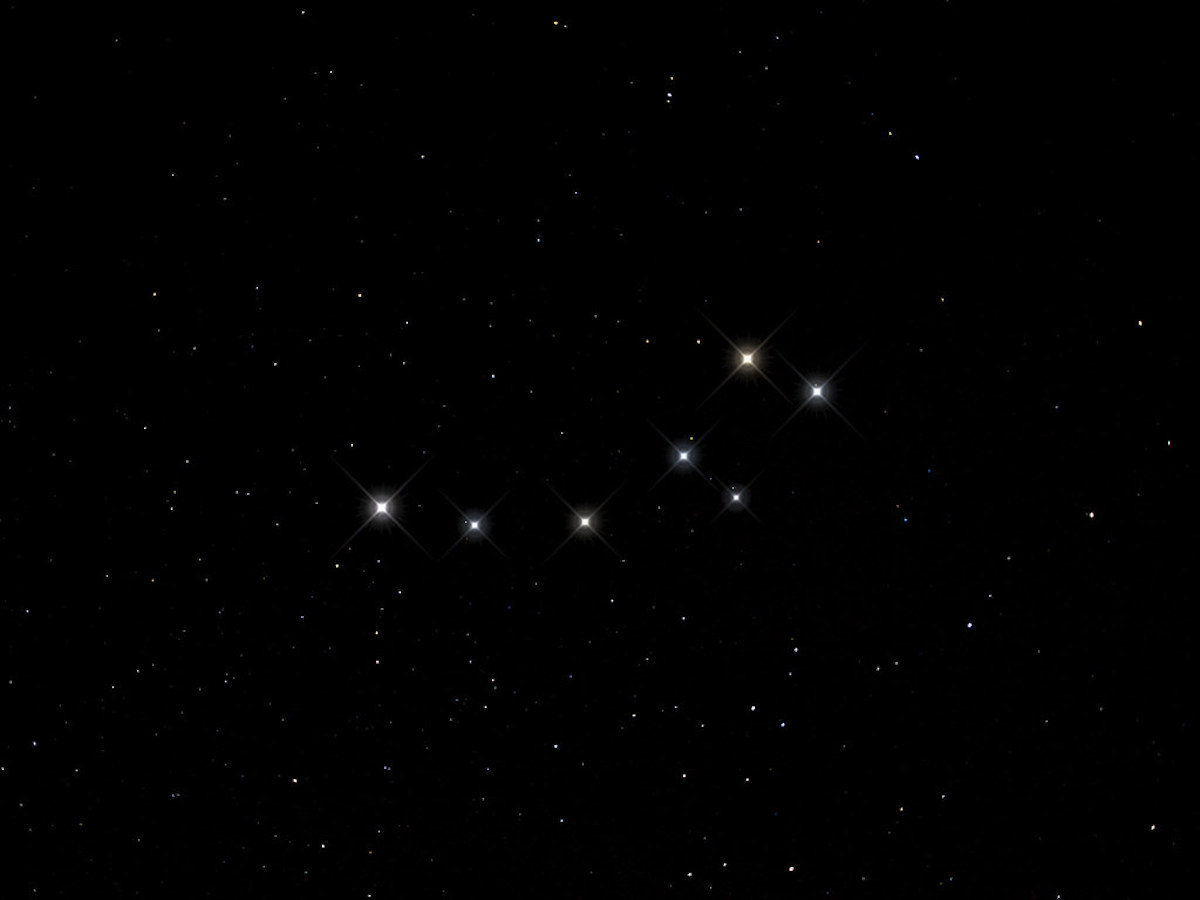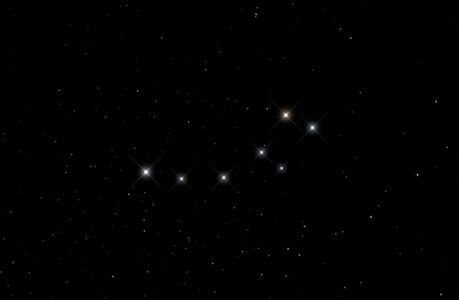The night sky has fascinated humanity since time immemorial. The stars and constellations that adorn the heavens have inspired awe, wonder, and imagination in people from all cultures and backgrounds. One of the most well-known constellations is Ursa Minor, also known as the Little Dipper. Ursa Minor is a prominent constellation in the northern hemisphere, and its stars are visible throughout the year from Ireland. In this article, we will explore the mythology and history surrounding Ursa Minor and provide a guide on how to view this celestial wonder from Ireland.
Mythology and History of Ursa Minor
In Greek mythology, Ursa Minor is associated with the story of Callisto, a beautiful nymph who catches the eye of Zeus, the king of the gods. Zeus transforms himself into a bear to seduce Callisto, but when Callisto becomes pregnant, Zeus’ wife Hera becomes jealous and turns Callisto into a bear. Callisto’s son, Arcas, almost kills her while hunting, but Zeus intervenes by turning Arcas into a bear as well and placing both bears in the sky as the constellations Ursa Major and Ursa Minor.
Ursa Minor has also been an important navigational tool for mariners since ancient times. The North Star, also known as Polaris, is located at the end of the constellation’s tail and has been used by sailors to navigate the seas for centuries. The North Star remains stationary in the sky while other stars appear to rotate around it, making it a reliable point of reference for determining direction.
Viewing Ursa Minor from Ireland
Ursa Minor is visible from Ireland throughout the year, but the best time to view it is during the summer months when the nights are clear and the skies are dark. To view Ursa Minor, find a location away from city lights with an unobstructed view of the northern horizon. Look for the two brightest stars at the end of the constellation’s bowl, known as the “pointer stars,” which point to Polaris, the North Star.
If you have binoculars or a telescope, you can get a closer look at the stars that make up Ursa Minor. The seven stars that make up the constellation are all relatively dim, with the brightest being only a third as bright as the faintest star in the Big Dipper. However, with a little patience and some practice, you should be able to identify each of the stars that make up the constellation.
Ursa Minor is a fascinating constellation with a rich mythology and history. Its stars have been used for navigation for centuries and continue to inspire wonder and awe in stargazers today. Viewing Ursa Minor from Ireland is a treat for anyone interested in astronomy or mythology, and with a little patience and some clear skies, you can witness this celestial wonder for yourself. So, pack your binoculars, find a dark spot away from city lights, and enjoy the beauty of Ursa Minor, the Little Dipper.
How can I see the constellation of Ursa Minor from Ireland?
Ursa Minor, also known as the Little Dipper, is a prominent constellation in the northern hemisphere and is visible from Ireland throughout the year. Here are some tips on how to see Ursa Minor from Ireland:
- Find a dark location away from city lights: Ursa Minor can be difficult to see if there is too much light pollution, so it’s best to find a location away from city lights. Look for a spot that has a clear view of the northern horizon.
- Look for the North Star: Ursa Minor is anchored by the North Star, also known as Polaris, which is located at the end of the constellation’s tail. Polaris is the brightest star in Ursa Minor and is always visible in the northern sky.
- Look for the “pointer stars”: Ursa Minor is shaped like a small ladle or dipper, with two stars at the end of the bowl that are known as the “pointer stars.” These stars point towards Polaris, making it easy to locate.
- Be patient: Ursa Minor is not as bright or as large as some other constellations, so it can take some time to spot all of its stars. Take your time and give your eyes a chance to adjust to the darkness.
- Use binoculars or a telescope: If you have binoculars or a telescope, you can get a closer look at the stars that make up Ursa Minor. The seven stars that make up the constellation are all relatively dim, with the brightest being only a third as bright as the faintest star in the Big Dipper. However, with a little patience and some practice, you should be able to identify each of the stars that make up the constellation.
By following these tips, you should be able to see Ursa Minor from Ireland and enjoy the beauty of this celestial wonder.
The mythology of the constellation of Ursa Minor
The constellation of Ursa Minor, also known as the Little Dipper, has a rich mythology that dates back to ancient times. In Greek mythology, Ursa Minor is associated with the story of Callisto, a beautiful nymph who catches the eye of Zeus, the king of the gods.
According to the myth, Zeus transforms himself into a bear to seduce Callisto, but when Callisto becomes pregnant, Zeus’ wife Hera becomes jealous and turns Callisto into a bear. Callisto’s son, Arcas, almost kills her while hunting, but Zeus intervenes by turning Arcas into a bear as well and placing both bears in the sky as the constellations Ursa Major and Ursa Minor.
The story of Callisto and Ursa Minor is often interpreted as a cautionary tale about the dangers of succumbing to temptation and the consequences of infidelity. The constellation of Ursa Minor is said to represent Callisto as a bear, while the two brightest stars at the end of the constellation’s bowl, known as the “pointer stars,” are said to represent Callisto’s son Arcas.
In other cultures, Ursa Minor has different mythological associations. In Norse mythology, Ursa Minor is known as Odin’s Wain, or Odin’s wagon, and is said to be pulled by two goats, Tanngrisnir and Tanngnjóstr. In Hindu mythology, Ursa Minor is associated with the story of Dhruva, a prince who meditated so intensely that he became immortal and was placed in the sky as the North Star.
Throughout history, Ursa Minor has been an important navigational tool for mariners, and its association with the North Star has made it a symbol of guidance and direction. The constellation’s mythology and cultural significance have inspired countless stories and legends, making it a beloved and enduring part of human history and culture.
The Stars in the constellation of Ursa Minor
The constellation of Ursa Minor, also known as the Little Dipper, is made up of seven stars that form the shape of a small ladle or dipper in the northern sky. The stars that make up Ursa Minor are relatively dim compared to other bright constellations, but they are still visible to the naked eye in a dark sky.
Here are the seven stars that make up Ursa Minor, listed in order of brightness:
- Polaris – Polaris, also known as the North Star, is the brightest star in Ursa Minor and is located at the end of the constellation’s tail. Polaris is a yellow supergiant star that is about 430 light-years away from Earth. It is a useful navigational tool, as it remains stationary in the sky while other stars appear to rotate around it.
- Kochab – Kochab is the second brightest star in Ursa Minor and is located at the end of the constellation’s bowl opposite Polaris. Kochab is an orange giant star that is about 126 light-years away from Earth.
- Pherkad – Pherkad is the third brightest star in Ursa Minor and is located between Polaris and Kochab. Pherkad is a blue-white subgiant star that is about 487 light-years away from Earth.
- Yildun – Yildun is the fourth brightest star in Ursa Minor and is located between Kochab and Pherkad. Yildun is a yellow-white main sequence star that is about 103 light-years away from Earth.
- Epsilon Ursae Minoris – Epsilon Ursae Minoris is the fifth brightest star in Ursa Minor and is located near the handle of the constellation’s ladle shape. Epsilon Ursae Minoris is a double star system, with two stars orbiting each other. The stars are both yellow-white main sequence stars that are about 304 light-years away from Earth.
- Zeta Ursae Minoris – Zeta Ursae Minoris is the sixth brightest star in Ursa Minor and is located near the base of the constellation’s handle. Zeta Ursae Minoris is a triple star system, with three stars orbiting each other. The stars are all yellow-white main sequence stars that are about 380 light-years away from Earth.
- Eta Ursae Minoris – Eta Ursae Minoris is the seventh brightest star in Ursa Minor and is located near the end of the constellation’s handle. Eta Ursae Minoris is a double star system, with two stars orbiting each other. The stars are both yellow-white main sequence stars that are about 97 light-years away from Earth.
While the stars that make up Ursa Minor are not as bright as some other prominent constellations, they are still a beautiful and fascinating part of the night sky, with rich mythology and cultural significance.
Deep sky objects visible in the Constellation of Ursa Minor
The constellation of Ursa Minor, also known as the Little Dipper, may not be as well-known for deep sky objects as other constellations, but there are still a few notable objects worth observing. Here are some of the deep sky objects visible in Ursa Minor:
- NGC 3172 – This is a small, faint spiral galaxy located near the star Kochab in Ursa Minor. It has a visual magnitude of 11.9 and is best viewed through a telescope with moderate to high magnification.
- NGC 6217 – This is a barred spiral galaxy located near the star Pherkad in Ursa Minor. It has a visual magnitude of 11.4 and is visible through a small telescope.
- Little Dumbbell Nebula (M76) – This planetary nebula is located near the star Kochab in Ursa Minor. It has a visual magnitude of 10.1 and is best viewed through a telescope with moderate to high magnification.
- Abell 31 – This is a planetary nebula located near the star Pherkad in Ursa Minor. It has a visual magnitude of 12.3 and is best viewed through a telescope with high magnification.
- IC 4665 – This is an open cluster of stars located near the star Yildun in Ursa Minor. It has a visual magnitude of 5.8 and is visible to the naked eye under dark skies. Binoculars or a small telescope can reveal more of the cluster’s stars.
While Ursa Minor may not have as many deep sky objects as other constellations, these objects are still a beautiful and fascinating part of the night sky. With patience, a good telescope or binoculars, and a clear, dark sky, stargazers can enjoy the beauty of these celestial wonders.

